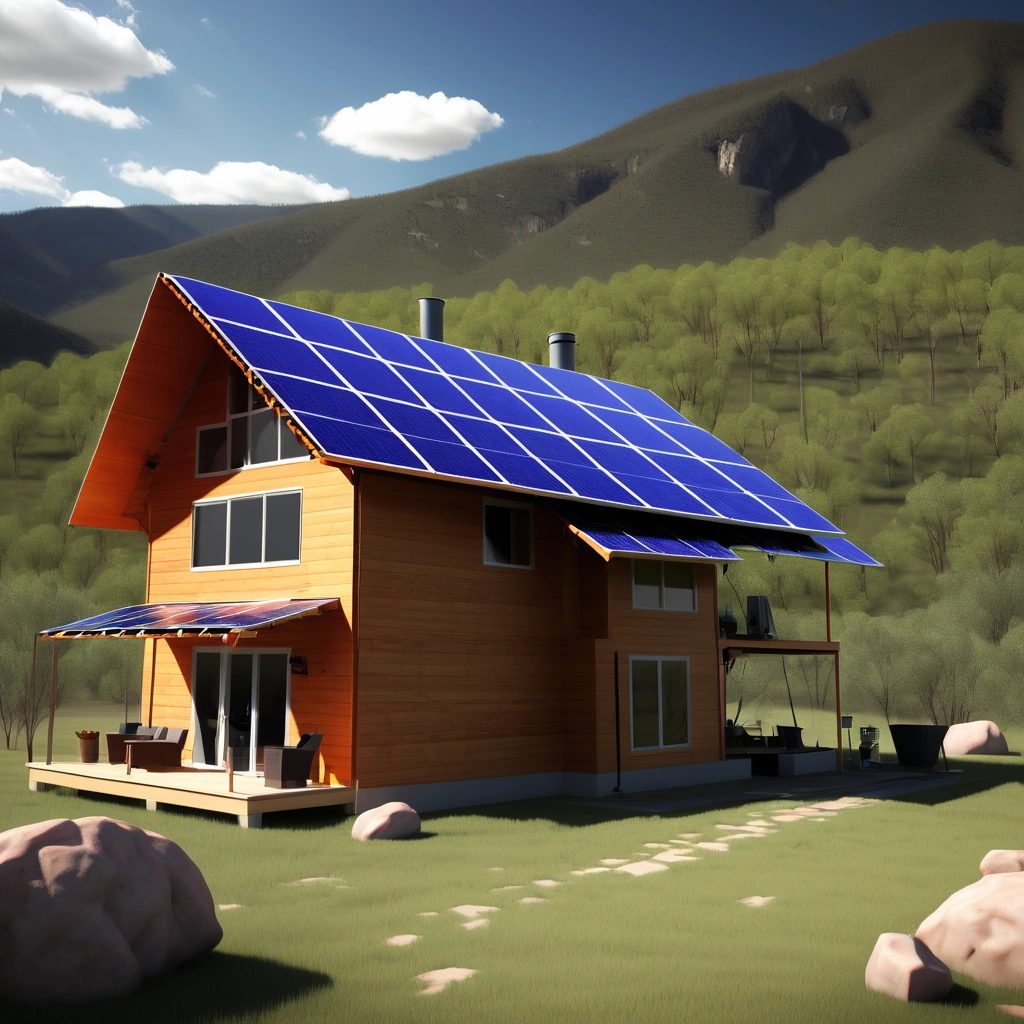Maximizing Solar Power for Off-Grid Living: A Comprehensive Guide to Designing and Maintaining Remote Property Systems
Introduction: Embracing Solar Independence in Remote Locations
For those seeking self-sufficiency far from the grid, solar power offers a compelling path to energy independence, representing a tangible step towards a more sustainable lifestyle. However, establishing a reliable solar energy system on a remote property presents unique challenges that demand careful planning and execution. This comprehensive guide provides the knowledge and strategies necessary to design, implement, and maintain a robust off-grid solar system, ensuring a sustainable power supply for years to come. This is more than just installing panels; it’s about creating a fully integrated remote power system.
The allure of off-grid living often stems from a desire for environmental stewardship and reduced reliance on traditional utilities. Achieving this requires a holistic approach, integrating advanced renewable energy systems with smart energy management strategies. Precise solar array sizing, tailored to location-specific irradiance and energy consumption patterns, is paramount. Battery storage solutions, carefully selected and meticulously maintained, form the backbone of a reliable system. Furthermore, efficient energy management systems, leveraging real-time data and automated controls, optimize energy usage and extend battery lifespan.
Consider, for example, a system utilizing micro-inverters on each panel for optimized performance in partially shaded areas, coupled with a smart thermostat that learns usage patterns to minimize energy waste. Looking ahead to the next decade (2030-2039), advancements in solar technology and energy management systems will further enhance the viability and efficiency of off-grid living. Expect to see more widespread adoption of perovskite solar cells, offering potentially higher efficiencies and lower manufacturing costs. Improved battery technologies, such as solid-state batteries, promise greater energy density, faster charging, and enhanced safety.
Smart home technologies will play an increasingly important role, optimizing energy consumption and providing remote monitoring capabilities. This guide will explore those advancements and provide a roadmap for future-proofing your remote power setup, ensuring your investment remains a valuable asset for decades to come. By 2025, complete off-grid living technology integration will be more accessible and streamlined than ever before, thanks to these innovations. Ultimately, successful off-grid living hinges on a commitment to continuous learning and adaptation.
Staying abreast of the latest technological advancements, understanding your energy consumption patterns, and proactively addressing maintenance needs are crucial for maximizing the lifespan and performance of your remote power systems. This guide serves as a starting point, empowering you to embark on your journey towards energy independence with confidence and foresight. Regular battery bank maintenance, for example, including equalization charges and terminal cleaning, can significantly extend battery life and prevent costly replacements. Similarly, understanding the nuances of solar charge controllers and inverters is essential for optimizing system performance and preventing damage.
Precise Solar Array Sizing: Optimizing for Location and Season
Accurate solar array sizing is paramount for a successful off-grid system. It begins with a thorough assessment of your energy needs, considering all appliances, lighting, and equipment you plan to use. Location-specific irradiance data, readily available from resources like the National Renewable Energy Laboratory (NREL) and PVWatts calculator, is crucial. These tools provide detailed information on solar radiation levels throughout the year, accounting for seasonal variations and weather patterns. Understanding the difference between peak sun hours in summer versus winter is essential for ensuring adequate power generation during the darker months.
Over-sizing the array slightly provides a buffer for unexpected energy demands and cloudy days, while under-sizing leads to frequent battery depletion and potential system damage. Careful consideration of panel tilt and orientation, adjusted for your specific latitude, further optimizes energy capture. Beyond readily available online tools, a professional energy audit offers invaluable insights for optimizing solar array sizing. Certified auditors assess your property’s energy consumption patterns, identify potential energy efficiency improvements, and provide tailored recommendations for solar power system design.
This is especially critical for remote properties where access to grid power for supplemental needs is nonexistent. For example, a study by the Rocky Mountain Institute found that implementing energy efficiency measures before installing a renewable energy system can reduce the required solar array size by up to 30%, significantly lowering upfront costs and improving long-term system performance for off-grid living. Consider the future when determining your solar array size. As technology advances between 2030-2039, you may integrate new, energy-intensive devices into your remote property.
Planning for electric vehicle charging, advanced water filtration systems, or even small-scale agricultural equipment requires anticipating future energy demands. Furthermore, battery storage capacity plays a vital role in array sizing. A larger battery bank allows you to capture and store excess solar energy during peak production times, providing a greater buffer against periods of low sunlight. Regular battery bank maintenance, including monitoring state of charge and performing necessary equalization cycles, ensures optimal storage capacity and extends the lifespan of your remote power systems.
Finally, remember that solar array sizing is not a one-time calculation but an ongoing process. Smart energy management systems provide real-time data on energy production and consumption, allowing you to fine-tune your system over time. By monitoring your energy usage patterns and adjusting your solar array configuration as needed, you can ensure that your off-grid system continues to meet your needs efficiently and reliably for years to come. This adaptive approach is crucial for maximizing the benefits of renewable energy and achieving true energy independence in remote locations.
Battery Bank Selection and Management: Maximizing Lifespan and Efficiency
The battery bank is the heart of any off-grid solar system, storing energy for use when the sun isn’t shining. The choice between lithium-ion and lead-acid batteries is a critical one, with each offering distinct advantages and disadvantages that directly impact the long-term viability of remote power systems. Lithium-ion batteries boast higher energy density, longer lifespans (often exceeding 10 years), and faster charging rates, making them ideal for demanding off-grid applications. However, this superior performance comes at a higher upfront cost, typically two to three times that of lead-acid options.
Lead-acid batteries, while more affordable, require more maintenance, including regular watering and equalization charging, and have a significantly shorter lifespan, typically 3-5 years. The decision hinges on balancing initial investment with long-term operational costs and performance requirements for your remote property. Capacity planning is crucial for battery storage; it involves calculating the total energy storage needed to meet your daily consumption, accounting for several days of autonomy during periods of low sunlight. This is especially important for properties relying on solar power in regions with extended periods of cloud cover or during winter months.
A common rule of thumb is to design for at least three days of autonomy, meaning the battery bank should be able to power the entire property for three days without any solar input. For example, a home consuming 10 kWh per day would need a battery bank capable of storing at least 30 kWh of usable energy. Furthermore, consider future energy needs as your off-grid living setup evolves, potentially adding more appliances or expanding your remote property.
Extreme temperatures can significantly impact battery performance and lifespan, a critical consideration for off-grid living in diverse climates. Both lithium-ion and lead-acid batteries experience reduced capacity and performance at very high and low temperatures. Implementing temperature-controlled enclosures, such as insulated battery boxes with ventilation or even burying battery banks underground, can mitigate these effects. For instance, in extremely cold climates, consider using battery warmers to maintain optimal operating temperatures. Conversely, in hot climates, adequate ventilation and shading are crucial to prevent overheating.
Investing in a battery management system (BMS) with temperature monitoring and control features is also highly recommended, especially for lithium-ion systems, to ensure safe and efficient operation. Looking towards 2030-2039, advanced battery technologies like solid-state batteries promise even greater temperature tolerance and safety, potentially revolutionizing battery storage for remote power systems. Regular maintenance, including equalization charging for lead-acid batteries and monitoring state of charge, is essential for maximizing battery lifespan and efficiency. Equalization charging helps to reverse sulfation, a process that reduces the capacity of lead-acid batteries.
Monitoring the state of charge (SOC) allows you to track energy usage and identify potential problems before they lead to battery damage. Many modern inverters and battery management systems provide detailed SOC information and automated maintenance features. Furthermore, consider implementing a load management strategy to minimize unnecessary energy consumption and extend battery life. This might involve using timers to control lighting or appliances, or investing in energy-efficient appliances. Proper battery bank maintenance not only extends the lifespan of your investment but also ensures the reliability of your off-grid solar power system for years to come.
Smart Energy Management: Remote Monitoring and Automated Control
Smart energy management systems are revolutionizing off-grid living, providing unprecedented control and insight into energy consumption. These systems offer remote monitoring capabilities, allowing you to track energy production from your solar array, battery state of charge, and load consumption from anywhere in the world. Imagine receiving real-time alerts on your smartphone if your battery bank’s state of charge drops below a critical threshold, or if a specific appliance is drawing excessive power. This level of granular data empowers you to make informed decisions about energy usage, optimizing your system’s performance and extending the lifespan of your valuable components.
Automated load shedding prioritizes essential appliances during periods of low power availability, preventing system overload. For example, during a prolonged cloudy period, the system might automatically reduce power to non-essential loads like electric vehicle charging or pool pumps, ensuring critical systems like refrigeration and lighting remain operational. Predictive maintenance features analyze system data to identify potential problems before they escalate, minimizing downtime and extending equipment lifespan. Smart thermostats, lighting controls, and appliance timers further optimize energy consumption by automatically adjusting settings based on occupancy and environmental conditions.
Integrating these technologies creates a more efficient and resilient off-grid power system. Delving deeper into the specifics of smart energy management, consider the advancements slated for the Complete Off-Grid Living Technology Integration Guide 2025. The next generation of systems will feature enhanced machine learning algorithms that predict energy production based on hyperlocal weather patterns and historical data. This allows for proactive adjustments to energy consumption, further minimizing reliance on backup generators. Moreover, advanced systems will integrate seamlessly with smart home ecosystems, providing voice-controlled energy management and personalized energy profiles for each household member.
Think of adjusting your home’s temperature and lighting with a simple voice command, all while optimizing your solar power usage. These advancements are particularly crucial for remote properties where access to technical support may be limited. To illustrate the impact of these systems, consider a case study of a remote eco-lodge in the Andes Mountains. Before implementing a smart energy management system, the lodge frequently experienced power outages due to unpredictable weather patterns and inefficient energy consumption.
After installing a system with remote monitoring and automated load shedding, the lodge reduced its reliance on diesel generators by 60% and significantly improved the guest experience. The system also provided valuable data on energy consumption patterns, allowing the lodge to identify and address inefficiencies, such as outdated appliances. As we move towards 2030-2039, expect to see even more sophisticated systems that incorporate blockchain technology for secure energy trading within microgrids, further enhancing the economic viability of off-grid living. The integration of such advanced energy management will be crucial in maximizing the efficiency of remote power systems.
Backup Power and Comprehensive Maintenance: Ensuring System Longevity
Even with a meticulously designed solar system optimized through precise solar array sizing, backup power solutions remain indispensable for ensuring an uninterrupted power supply, particularly in the context of remote property applications. Generators, traditionally powered by propane, gasoline, or diesel, represent the most prevalent backup option, offering readily available power on demand. However, aligning with the principles of Complete Off-Grid Living Technology Integration Guide 2025, a growing emphasis is placed on exploring more sustainable alternatives.
Micro-hydro systems, where feasible, and small-scale wind turbines present viable renewable energy sources that can seamlessly integrate with the primary solar power system. Seamless integration is paramount, necessitating automatic transfer switches that facilitate a smooth and immediate transition between power sources, ensuring critical loads remain energized during periods of solar deficit or system maintenance. This approach directly addresses the long-term sustainability goals inherent in advanced renewable energy systems for self-sufficient properties. Optimizing energy consumption stands as a cornerstone of effective remote power systems management, mitigating reliance on backup power and enhancing overall system efficiency.
Thoughtful appliance selection, prioritizing energy-efficient models with low standby power consumption, significantly curtails overall energy demand. Implementing robust insulation strategies within the framework of Ultimate Sustainable Home Design Framework for Remote Locations minimizes heat loss during winter and heat gain during summer, thereby reducing the energy burden associated with heating and cooling. Furthermore, strategic demand-side management, such as shifting energy-intensive tasks to periods of peak solar production, optimizes the utilization of available solar power, maximizing self-sufficiency and minimizing the need for supplementary power sources.
These strategies are particularly relevant as we approach the 2030-2039 timeframe, where energy efficiency standards are expected to become even more stringent. To ensure the longevity and reliable performance of off-grid living solar installations, rigorous and proactive maintenance protocols are essential for solar panels, battery banks, and inverters. Regular cleaning of solar panels to remove accumulated dirt, dust, and debris optimizes solar energy capture, maintaining peak power output. Thorough inspection of battery connections for corrosion and sulfation, coupled with adherence to recommended battery bank maintenance schedules, prolongs battery lifespan and ensures consistent energy storage capacity.
Monitoring inverter performance for any signs of malfunction or degradation, such as voltage fluctuations or excessive heat, enables timely intervention and prevents potentially catastrophic system failures. Implementing preventative measures, including surge protection to safeguard against voltage spikes and proper ventilation to dissipate heat, further enhances system resilience and minimizes the risk of costly repairs. Addressing these issues promptly, guided by best practices in battery storage and energy management, is crucial for maximizing the return on investment in remote power systems.


